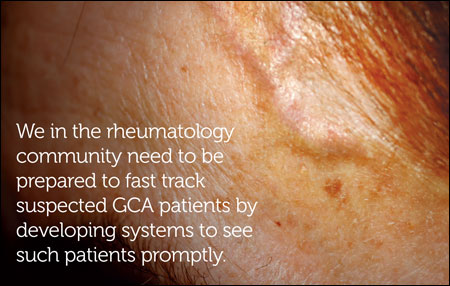Giant Cell Arteritis: A Call for Interprofessional Education and Collaboration
As rheumatologists, we relish new cases of giant cell arteritis in their classic form. We have the capacity to make a bedside diagnosis with considerable diagnostic accuracy when confronted by the elderly patient with new-onset headache, jaw claudication, polymyalgia with a tender and pulseless temporal artery. In reality, of course, this is not often the case.

What gives me pause, with all the buzz surrounding GCA fueled by advances in imaging and therapy, is where are these patients coming from and how can we optimize both diagnosis and management? We should all be aware that GCA, while rarely fatal, still is highly morbid with permanent visual loss in one out of five to six patients and the ravages of high-dose and/or long-term glucocorticoids observed in the majority of patients.
I like to consider the presentations of GCA in three buckets: The head and neck ischemia presentations with headache; jaw claudication; and stroke or visual symptoms. Classic, yes, but certainly not likely to be first seen by rheumatologists. Headache is likely the first domain of the generalist, whereas jaw claudication may be seen by dental health professionals and visual symptoms ranging from amaurosis fugax to partial visual loss or diplopia are often seen first by the ED physician, optometrist or ophthalmologist.
Let us remind ourselves that new-onset visual loss in untreated GCA is a medical emergency; if left untreated, this may progress to total visual loss, at times bilateral, in a significant percentage of patients within the first few weeks. Thus, alertness for such presentations and systems for prompt referrals are critical — fast-track clinics in Europe have been demonstrated to be effective.
Another point to consider is the patient with systemic constitutional symptoms. Polymyalgia rheumatica as a presentation is not uncommon and a generalist needs to be alerted to the possibility of concomitant GCA to appropriately query these patients for undescribed visual symptoms or jaw claudication (often ascribed to TMJ syndrome) to appropriately test and refer. Additionally, because 40% of GCA patients may present with fever — at times quite severe— and wind up in hospital with FUO or IUO (Inflammatory Disease of Unknown Origin), hospitalists, internists and subspecialists may not consider GCA when unattended by classic manifestations.
Lastly, large vessel involvement is present in most patients, and while largely asymptomatic, these patients may present with limb claudication, newly recognized large vessel aneurysmal disease or an unexplained murmur (as noted in the elegant case presented by Gary S. Hoffman, MD, MS, MACR, on Healio Rheumatology) or at times limb claudication or occult asymptomatic aortic aneurysm. None of these problems are likely to be seen initially by rheumatologists and thus the circle of care and the need for disease awareness widens.
Given the demonstrated efficacy of prompt diagnosis and treatment in limiting permanent visual loss and — with the approval of tocilizumab (Actemra, Genentech) — an available potent steroid-sparing agent, the need for interprofessional education is needed more than ever. We should model such efforts on the productive model of rheumatology-dermatology collaboration, which is leading to more optimized systems of disease recognition and management for psoriatic arthritis.
While skilled neuro-ophthalmologists are highly sensitized to GCA, I am told by academic leaders in this field that community ophthalmologists and optometrists may not be as prepared to aggressively pursue GCA when idiopathic forms of ischemic optic neuritis greatly outnumber arteritis forms. GCA and polymyalgia rheumatica are now topics that should be revisited at appropriate meetings for internists, ED physicians, hospitalists and others who may be diagnostic gatekeepers for new-onset disease.

Lastly, we in the rheumatology community need to be prepared to fast track suspected GCA patients by developing systems to see such patients promptly, and by collaborating with ophthalmologists and other specialists in the care team who are invested in GCA and willing to see such patients in a facilitated fashion.
- For more information:
- Leonard H. Calabrese, DO, is the Chief Medical Editor, Healio Rheumatology, and Professor of Medicine, Cleveland Clinic Lerner College of Medicine of Case Western Reserve University, and RJ Fasenmyer Chair of Clinical Immunology at the Cleveland Clinic.
Disclosure: Calabrese reports serving as an investigator and a consultant to Horizon Pharmaceuticals.
